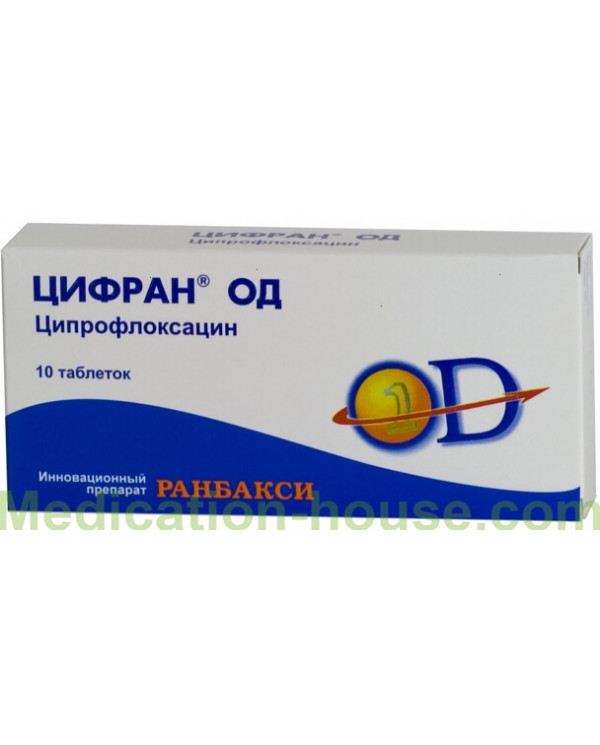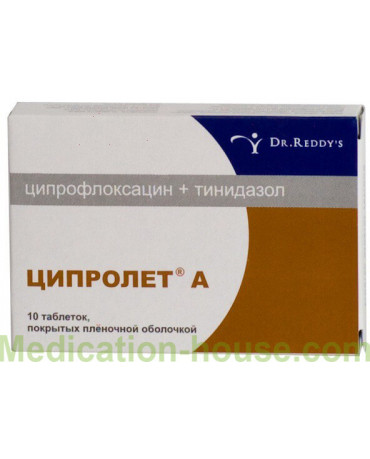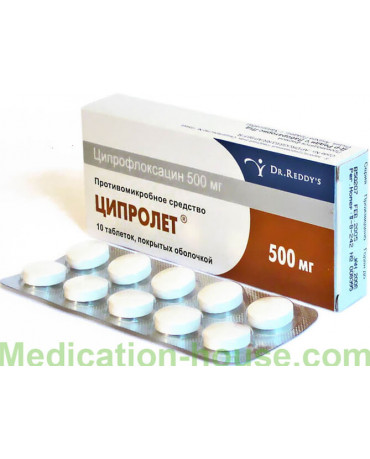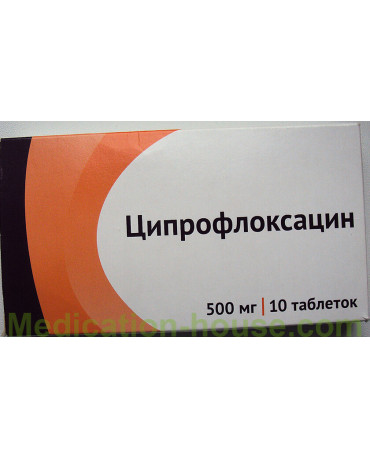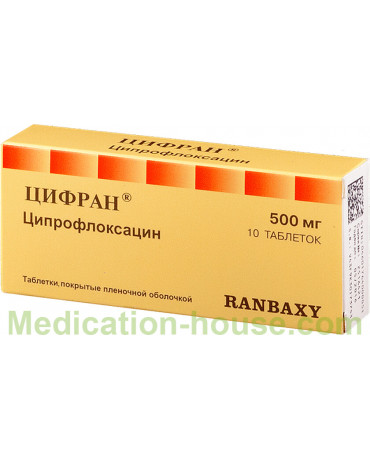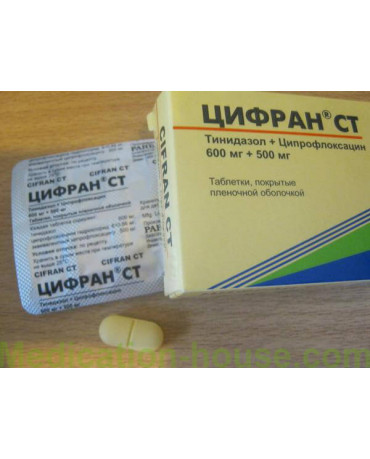Cifran OD instruction
You can buy Cifran OD here
Composition
One tablet contains
active ingredient - ciprofloxacin 500 mg and 1000 mg
Excipients:
Intragranulate: sodium alginate, hypromellose, sodium bicarbonate, crospovidone, magnesium stearate;
extragranulate: magnesium stearate, purified talcum, anhydrous colloidal silicon dioxide;
casing: opadray 31B58910 white (hypromellose, lactose monohydrate, titanium dioxide (E171), macrogol 400, hypromellose, purified talc;
Opacode S-1-17823 (Black) ink: shellac, glossy, isopropyl alcohol, ferric oxide / ferrous oxide black (E 172), butyl alcohol, propylene glycol, 28% ammonia solution.
Description
The tablets are oval-shaped, film-coated from white to almost white, with the inscription “Cifran OD 500 MG” in ink on one side. The length is 17.1 0.1 mm, the width is 8.1 0.1 mm, the thickness is 5.6 0.3 mm (for dosage 500 mg).
The tablets are oval-shaped, film-coated from white to almost white, with the inscription “Cifran OD 1000 MG” in ink on one side. The length is 21.2 0.1 mm, the width is 10.6 0.1 mm, the thickness is 7.6 0.3 mm (for a dosage of 1000 mg).
Pharmacotherapeutic group
Antibacterial drugs for system use. Antimicrobial drugs - derivatives of quinolone. Fluoroquinolones. Ciprofloxacin.
Pharmacokinetics of Cifran OD
Ciprofloxacin tablets with prolonged action are designed to release Cifran OD at a lower rate compared with the quick release tablets.
The pharmacokinetic profile of ciprofloxacin tablets with a prolonged effect of 1000 mg once a day is comparable to the profile of 500 mg of ciprofloxacin tablets with a quick release twice a day, in terms of comparable AUC over a 24-hour dosing period.
Suction
After oral administration, ciprofloxacin is rapidly absorbed mainly in the small intestine. The maximum concentration of ciprofloxacin in the serum is reached in 1-2 hours. Bioavailability is about 70-80%. The values of the maximum plasma concentration (Cmax) and the area under the concentration-time curve (AUC) increase in proportion to the dose.
Distribution
The connection of ciprofloxacin with plasma proteins is 20-30%; the active substance is present in the blood plasma mainly in non-ionized form. Ciprofloxacin is freely distributed in the tissues and body fluids. The volume of distribution in the body is 2-3 l / kg. The concentration of ciprofloxacin in the tissues significantly exceeds the concentration in serum.
Metabolism
Biotransforming in the liver. The blood can be detected four metabolite ciprofloxacin in small concentrations: dietiltsiprofloksatsin (Ml), sulfotsiprofloksatsin (M2) oksotsiprofloksatsin (MH) formiltsiprofloksatsin (M4), three of which (M1-MH) exhibit antibacterial activity in vitro, comparable with antibacterial activity nalidixic acid. The in vitro antibacterial activity of the metabolite M4, which is present in a smaller amount, is more consistent with the activity of norfloxacin.
Removal
Ciprofloxacin is excreted mainly by the kidneys by glomerular filtration and tubular secretion; a small amount through the gastrointestinal tract. Removal with urine occurs within 24 hours after taking Cifran OD. From 1 to 2% of the dose taken is excreted in the bile as metabolites, about 20-35% of Cifran OD is excreted in the feces within 5 days after administration. The serum half-life in patients with normal renal function is approximately 7 hours.
Elderly
Pharmacokinetic analyzes of oral immediate-release tablets (single dose) and ciprofloxacin forms for intravenous administration (single and multiple doses) show that plasma ciprofloxacin concentrations are higher in the elderly (over 65) compared with young adults. Cmax increases from 16% to 40%, and the average AUC increases by approximately 30%, which may be at least partially caused by a decrease in renal clearance in the elderly. The elimination half-life is only slightly longer in the elderly (~ 20%). These differences are not clinically significant.
Renal failure
In patients with reduced kidney function, the half-life of ciprofloxacin may be prolonged. Dose adjustment is not required in patients with uncomplicated urinary tract infections receiving 500 mg of the dosage form of ciprofloxacin with a prolonged action. For complicated urinary tract infections and acute uncomplicated pyelonephritis, where a dose of 1000 mg is applied, the dosage form of ciprofloxacin with a prolonged action should be reduced to 500 mg once a day (creatinine clearance below 30 ml / min).
Liver failure
In the study of patients with stable chronic liver cirrhosis, no significant changes in the pharmacokinetics of ciprofloxacin were observed. In this case, the kinetics of ciprofloxacin in patients with acute liver failure was not sufficiently identified.
Pharmacodynamics
Ciprofloxacin is a synthetic broad spectrum antibacterial drug from the group of fluoroquinolones.
Mechanism of action
Ciprofloxacin has in vitro activity against a wide range of gram-negative and gram-positive microorganisms. The bactericidal effect of ciprofloxacin is carried out by inhibiting type II bacterial topoisomerases (topoisomerase II (DNA gyrase) and topoisomerase IV), which are necessary for replication, transcription, repair and recombination of bacterial DNA.
Resistance mechanisms
In vitro resistance to ciprofloxacin is often caused by point mutations of bacterial topoisomerases and DNA gyrase and develops slowly through multi-stage mutations.
Single mutations can lead to a decrease in sensitivity rather than to the development of clinical resistance, however, multiple mutations mainly lead to the development of clinical resistance to ciprofloxacin and to cross-resistance to quinolone drugs. Resistance to ciprofloxacin, like many other antibiotics, can be formed by reducing the permeability of the bacterial cell wall (as often happens in the case of Pseudomonas aeruginosa) and / or activating the elimination from the microbial cell (efflux). The development of resistance due to the Qnr coding gene localized on plasmids has been reported. The mechanisms of resistance that lead to the inactivation of penicillins, cephalosporins, amino glycosides, macrolides and tetracyclines probably do not violate the antibacterial activity of ciprofloxacin. Microorganisms resistant to these drugs can be sensitive to ciprofloxacin. The minimum bactericidal concentration (MBC) usually does not exceed the minimum inhibitory concentration (MIC) more than 2 times.
Cross-resistance. Cross-resistance between ciprofloxacin and antimicrobial drugs of other classes is not observed.
Ciprofloxacin is active against most strains of the following bacteria, both in vitro and in clinical practice in the treatment of infections.
Aerobic gram-positive microorganisms: Bacillus anthracis, Staphylococcus aureus (methicillin-sensitive), Staphylococcus saprophyticus, Streptococcus spp. Aerobic Gram Nets Yersinia pestis. Anaerobic microorganisms: Mobiluncus spp.
Other microorganisms: Chlamydia trachomatis, Chlamydia pneumoniae, Mycoplasma hominis, Mycoplasma pneumoniae. Been able to have a lookout , Proteus vulgaris, Providencia spp., Pseudomonas aeruginosa, Pseudomonas fluorescens, Serratia marcescens, Streptococcus pneumoniae, Peptostreptococcus spp., Propionibacterium acnes. It is considered that natural resistance to ciprofloxacin is provided by Staphylococcus aureus (Meticillin-resistant), Listeria Monocytogenes, Mycoplasma Genitalium, Ureaplasma Modernization Services Ltd. ).
Indications for use
Uncomplicated and complicated infections caused by microorganisms sensitive to ciprofloxacin.
Adults
- respiratory tract infections. Ciprofloxacin is recommended to be given for pneumonia caused by Klebsiella spp., Enterobacter spp., Proteus spp., Esherichia coli, Pseudomonas aeruginosa, Haemophilus spp., Moraxella catarrhalis, Legionella spp. and staphylococcus
- infections of the middle ear (otitis media), paranasal sinuses (sinusitis), especially if these infections are caused by gram-negative microorganisms, including Pseudomonas aeruginosa or staphylococcus,
- eye infections
- infections of the kidneys and / or urinary tract
- genital infections, including adnexitis, gonorrhea, prostatitis
- infections of the abdominal cavity (bacterial infections of the gastrointestinal tract, biliary tract, peritonitis)
- skin and soft tissue infections
- sepsis
- infections or prevention of infections in patients with reduced immunity (patients taking immunosuppressants or patients with neutropenia)
- selective intestinal decontamination in patients with reduced immunity
- prevention and treatment of pulmonary anthrax (infection with Bacillus anthracis)
- prevention of invasive infections caused by Neisseria meningitidis.
It is necessary to take into account the current official guidelines on the rules for the use of antibacterial agents.
Children
- treatment of complications caused by Pseudomonas aeruginosa in children with cystic fibrosis of the lungs from 5 to 17 years old
- prevention and treatment of pulmonary anthrax (infection with Bacillus anthracis)
Dosage and administration
Tablets must be swallowed without chewing, drinking water. They can be taken regardless of meal times. When taken on an empty stomach, the active substance is absorbed faster.
Cifran OD tablets are taken once a day.
The dosage and course of treatment depend on the indications, the degree of severity and localization of the infection, susceptibility of the pathogenic microorganism (s) to ciprofloxacin, the renal function of patients and the clinical and bacteriological effectiveness.
For the treatment of certain bacterial infections (eg Pseudomonas aeruginosa, Acinetobacter or Staphylococci), higher doses of ciprofloxacin and co-administration with other appropriate antibacterial agents may be needed.
For the treatment of certain infections (eg inflammatory diseases of the pelvic organs, intra-abdominal infections, infections in neutropenic patients, and infections of bones and joints), co-administration with other appropriate antibacterial agents may be necessary depending on the pathogens involved.
Geriatric Patients
Geriatric patients should be administered a dose depending on the severity of the infection and creatinine clearance.
Renal failure
Ciprofloxacin is mainly excreted in the urine; however, Cifran OD is also metabolized and partially excreted through the biliary system of the liver and through the intestines. Patients with uncomplicated urinary tract infections, receiving 500 mg of ciprofloxacin tablets with prolonged action, dosage adjustment is not required. Patients with complicated urinary tract infections and acute uncomplicated pyelonephritis with creatinine clearance <30 ml / min should reduce the dose of ciprofloxacin tablets with prolonged action from 1000 mg to 500 mg per day. Patients on hemodialysis or peritoneal dialysis are administered ciprofloxacin tablets with a prolonged effect after completion of the dialysis procedure.
Liver failure
Patients with stable chronic cirrhosis do not need to adjust the dosage of long-acting ciprofloxacin tablets. However, the kinetics of ciprofloxacin in patients with acute liver failure has not been fully studied.
Side effects of Cifran OD
The adverse reactions listed below were classified as follows: “very often” (> 10), “often” (> 1/100, <1/10), “infrequently” (> 1/1000, <1/100), “rarely” (> 1/10 000, <1/1000), "very rarely" (<10 000), "frequency unknown."
Often
- nausea, diarrhea, reactions at the injection site
Infrequently
- mycotic superinfection
- eosinophilia
- decrease in appetite and quantity of the eaten food
- psychomotor hyperactivity / agitation
- headache, dizziness, sleep disturbance, taste disturbance
- vomiting, abdominal pain, dyspepsia, flatulence
- increased activity of liver transaminases, increased bilirubin concentration
- rash, itching, urticaria
- arthralgia
- impaired renal function
- pain syndrome of non-specific etiology, general malaise, fever
- increased activity of alkaline phosphatase in the blood
Seldom
- pseudo-membranous colitis (in very rare cases with possible death)
- leukopenia, anemia, neutropenia, leukocytosis, thrombocytopenia
- allergic reactions, allergic edema / angioedema
- hyperglycemia, hypoglycemia
- confusion and disorientation, anxiety, disturbed dreams (nightmares), depression (increased behavior for the purpose of self-harm, such as suicidal acts / thoughts, as well as attempted suicide or a successful suicide), hallucinations
- paresthesia and dysesthesia, hypoesthesia, tremor, convulsions (including epileptic seizures), vertigo
- visual disturbances, tinnitus, hearing loss
- tachycardia, vasodilation, lowering blood pressure, feeling the "tide" of blood to the face
- respiratory failure (including bronchospasm)
- abnormal liver function, jaundice, hepatitis (non-infectious)
- photosensitization, blistering of unspecified etiology
- myalgia, arthritis, increased muscle tone, muscle cramps
- renal failure, hematuria, crystalluria, tubulointerstitial nephritis
- swelling, sweating (hyperhidrosis)
- change in the concentration of prothrombin, increased amylase activity
Very rarely
- hemolytic anemia, agranulocytosis, pancytopenia (life threatening), bone marrow suppression (life threatening)
- anaphylactic reactions, anaphylactic shock (life threatening), serum sickness
- psychotic reactions (enhancing behavior for the purpose of self-harm such as suicidal acts / thoughts, as well as attempted suicide or a successful suicide)
- migraine, impaired motor coordination, impaired sense of smell, hyperesthesia, intracranial hypertension (cerebral pseudotumorous symptoms)
- impaired color perception, impaired hearing
- vasculitis, pancreatitis
- liver tissue necrosis (in extremely rare cases, progressing to life-threatening liver failure)
- petechiae, erythema multiforme of small forms, erythema nodosum, Stevens Johnson syndrome (malignant exudative erythema), including potentially life-threatening, Lyell's syndrome (toxic epidermal necrolysis), including potentially life-threatening
- muscular weakness, tendonitis, tendon rupture (mainly Achilles), exacerbation of symptoms of myasthenia
- gait disturbance
Frequency unknown
- peripheral neuropathy and polyneuropathy
- prolongation of the QT interval, ventricular arrhythmias (including the “pirouette” type)
- acute generalized pustular rash
- increased MHO (in patients receiving vitamin K antagonists)
Contraindications
- hypersensitivity to ciprofloxacin or other quinolone class antibacterial drugs, as well as hypersensitivity to Cifran OD components
- simultaneous reception with tizanidine, theophylline
- children's and teenage age up to 18 years
- pregnancy and lactation
- epilepsy, seizures convulsions in history, organic brain damage
- pseudomembranous colitis
- deficiency of glucose-6-phosphate dehydrogenase
Drug interactions
Drugs that cause prolongation of the QT interval
Caution should be exercised with the simultaneous use of ciprofloxacin, as well as other fluoroquinolones, patients receiving drugs that cause prolongation of the QT interval (for example, antiarrhythmic drugs of class I A or class III. Tricyclic antidepressants, macrolides, antipsychotics) (see the Special Instructions section ").
Formation of chelate compounds
Simultaneous intake of tablets of ciprofloxacin and cation-containing preparations, mineral supplements containing calcium, magnesium, aluminum, iron, sucralfate, antacids, polymeric phosphate compounds (such as sevelamer, lanthanum carbonate) and drugs with a large buffer capacity (such as didanosine tablets) containing magnesium, aluminum or calcium, reduces the absorption of ciprofloxacin. In such cases, ciprofloxacin should be taken either 1-2 hours before or 4 hours after taking these drugs.
This restriction does not apply to drugs belonging to the class of H2-histamine receptor blockers.
Eating and dairy products
The simultaneous use of ciprofloxacin and dairy products or drinks enriched with minerals (for example, milk, yogurt, calcium-fortified orange juice) should be avoided, since the absorption of ciprofloxacin may decrease. However, calcium, which is part of other foods, does not significantly affect the absorption of ciprofloxacin.
Omeprazole
With the combined use of ciprofloxacin and drugs containing omeprazole, there may be a slight decrease in the maximum plasma concentration of Cifran OD and a decrease in the area under the concentration-time pharmacokinetic curve.
Theophylline
The simultaneous use of ciprofloxacin and drugs containing theophylline may cause an undesirable increase in plasma concentration of theophylline and, accordingly, the occurrence of theophylline-induced adverse events; in very rare cases, these adverse events can be life threatening for the patient. If the simultaneous use of these two drugs is unavoidable, it is recommended to continuously monitor the concentration of theophylline in the blood plasma and, if necessary, reduce the dose of theophylline (see the section "Specific Instructions", cytochrome P450).
Other xanthine derivatives
The simultaneous use of ciprofloxacin and caffeine or pentoxifylline (oxpentifylline) can lead to an increase in the concentration of xanthine derivatives in the blood serum.
Nonsteroidal anti-inflammatory drugs
The combination of very high doses of quinolones (DNA gyrase inhibitors) and some nonsteroidal anti-inflammatory drugs (excluding acetylsalicylic acid) can provoke seizures.
Cyclosporine
With the simultaneous use of ciprofloxacin and drugs containing cyclosporine, a transient increase in plasma creatinine levels was observed for a short time. In such cases, it is necessary to determine the concentration of creatinine in the blood twice a week.
Oral hypoglycemic agents
With simultaneous use of ciprofloxacin and oral hypoglycemic agents, mainly sulfonylurea drugs (for example, glibenclamide. Glimepiride), the development of hypoglycemia is presumably due to the increased effect of oral hypoglycemic agents (see the “Side effect” section).
Probenecid
Probenecid slows down the rate of excretion of ciprofloxacin by the kidneys. The simultaneous use of ciprofloxacin and drugs containing probenecid, leads to an increase in the concentration of ciprofloxacin in the blood plasma.
Phenytoin
With the simultaneous use of ciprofloxacin and phenytoin, a change (increase or decrease) in the plasma phenytoin content was observed. In order to avoid a weakening of the anticonvulsant effect of phenytoin due to a decrease in its concentration, as well as to prevent adverse events associated with an overdose of phenytoin when ciprofloxacin is discontinued, it is recommended to monitor phenytoin therapy in patients taking both drugs, including the determination of phenytoin in the blood plasma throughout period of simultaneous use of both drugs and a short time after the completion of combination therapy.
Methotrexate
With simultaneous use of methotrexate and ciprofloxacin, renal tubular transport of methotrexate can be slowed down, which may be accompanied by an increase in the concentration of methotrexate in the blood plasma. This may increase the likelihood of side effects of methotrexate. In this regard, patients receiving simultaneous therapy with methotrexate and ciprofloxacin, should be carefully monitored.
Tizanidine
As a result of a clinical study involving healthy volunteers with simultaneous use of ciprofloxacin and drugs containing tizanidine, an increase in serum tizanidine concentration was found: an increase in the maximum concentration (C max) 7 times (from 4 to 21 times), an increase in AUC (area under pharmacokinetic the curve "concentration time") 10 times (from 6 to 24 times). An increase in serum tizanidine concentration may cause a decrease in blood pressure and drowsiness. Thus, the simultaneous use of ciprofloxacin and preparations containing tizanidine, is contraindicated.
Duloxetine
During clinical studies, it was shown that the simultaneous use of duloxetine and potent inhibitors of the CYP450 1A2 isoenzyme (such as fluvoxamine) can lead to an increase in AUC and Cmax of duloxetine. Despite the lack of clinical data on possible interactions with ciprofloxacin, it is possible to predict the likelihood of such an interaction with simultaneous use of ciprofloxacin and duloxetine.
Ropinirol
The simultaneous use of ropinirole and ciprofloxacin, a moderate inhibitor of the CYP450 1A2 isoenzyme, leads to an increase in Cmax and AUC of ropinirole by 60 and 84%, respectively. The adverse effects of ropinirole should be monitored during its combined use with ciprofloxacin and for a short time after the completion of combination therapy.
Lidocaine
In a study on healthy volunteers, it was found that the simultaneous use of drugs containing lidocaine and ciprofloxacin, a moderate inhibitor of the CYP450 1A2 isoenzyme, leads to a decrease in lidocaine clearance by 22% when administered intravenously. Despite the good tolerability of lidocaine with simultaneous use with ciprofloxacin, increased side effects due to the interaction are possible (see the section "Special Instructions", Cytochrome P450).
Clozapine
With simultaneous use of clozapine and ciprofloxacin at a dose of 250 mg for 7 days, an increase in serum concentrations of clozapine and N-desmethylclozapine was observed by 29% and 31%, respectively. The patient’s condition should be monitored and, if necessary, correction of the clozapine dosing regimen during its combined use with ciprofloxacin and for a short time after the completion of the combination therapy (see the section “Special Instructions”, Cytochrome P450).
Sildenafil
With simultaneous use in healthy volunteers of ciprofloxacin at a dose of 500 mg and sildenafil at a dose of 50 mg, there was a 2-fold increase in Cmax and AUC of sildenafil. In this regard, the use of this combination is possible only after assessing the ratio of benefit / risk.
Vitamin K Antagonists
The combined use of ciprofloxacin and vitamin K antagonists (for example, warfarin, acenocoumarol, fenprocumone, fluindone) can lead to an increase in their anticoagulant action. The magnitude of this effect may vary depending on co-infections, age and general condition of the patient, therefore it is difficult to assess the effect of ciprofloxacin on the increase in MPE (internationally normalized ratio). It is often necessary to monitor MHO during the combined use of ciprofloxacin and vitamin K antagonists, as well as for a short time after the completion of combination therapy.
special instructions
Severe infections, staphylococcal infections and infections caused by gram-positive and anaerobic bacteria
When treating severe infections, staphylococcal infections and infections caused by anaerobic bacteria, ciprofloxacin should be used in combination with appropriate antibacterial agents.
Streptococcus pneumoniae infections
The drug Cifran OD is not recommended for the treatment of infections caused by Streptococcus pneumoniae, because of its limited efficacy against the pathogen.
Genital tract infections
When genital infections, presumably caused by strains of Neisseria gonorrhoeae that are resistant to fluoroquinolones, should be considered information on local resistance to ciprofloxacin and confirm the sensitivity of the causative agent with laboratory tests.
Heart disorders
Ciprofloxacin affects the prolongation of the QT interval (see the “Adverse Effects” section). Given that women have a large average QT interval compared with men, they are more sensitive to drugs that cause a prolongation of the QT interval. Elderly patients also have an increased sensitivity to the action of drugs that cause lengthening of the QT interval. Ciprofloxacin should be used with caution in combination with drugs that prolong the QT interval (for example, antiarrhythmic drugs of classes I A and III, tricyclic antidepressants, macrolides and antipsychotic drugs) (see section "Interaction with other drugs"), or in patients with elevated the risk of lengthening the QT interval or the development of a pirouette-type arrhythmia (for example, with congenital syndrome of prolonged QT interval, uncorrected electrolyte imbalances, such as hypokalemia or hypoma Niemi. and heart diseases such as heart failure, myocardial infarction, bradycardia).
Use in children
It was found that ciprofloxacin, like other drugs of this class, causes arthropathy of large joints in animals. When analyzing the current data on the safety of ciprofloxacin in children under 18 years old, most of whom have pulmonary cystic fibrosis, no connection has been established between the damage of cartilage or joints to the use of Cifran OD. It is not recommended to use ciprofloxacin in children for the treatment of other diseases, except for the treatment of complications of cystic fibrosis of the lungs (in children from 5 to 17 years) associated with Pseudomonas aeruginosa and for the treatment and prevention of pulmonary anthrax (after suspected or proven infection with Bacillus anthracis).
Hypersensitivity
Sometimes after taking the first dose of ciprofloxacin, hypersensitivity to Cifran OD may develop (see the “Side Effects” section), including allergic reactions, which should be immediately reported to your doctor. In rare cases, after the first use, anaphylactic reactions can occur up to anaphylactic shock. In these cases, the use of the drug Cifran OD should be immediately stopped and appropriate treatment should be carried out.
Gastrointestinal tract
When severe and prolonged diarrhea occurs during or after treatment with ciprofloxacin, diagnosis of pseudomembranous colitis should be excluded, which requires immediate discontinuation of Cifran OD and appropriate treatment (vancomycin orally at a dose of 250 mg 4 times a day). In this situation, the use of drugs that suppress intestinal motility is contraindicated.
Hepatobiliary system
When using ciprofloxacin, there were cases of liver necrosis and life-threatening liver failure. If you have the following signs of liver disease, such as anorexia, jaundice, dark urine, itching, painful abdomen, taking Cifran OD should be discontinued (see the section “Side Effects”),
In patients taking the drug Cifran OD and undergoing liver disease, there may be a temporary increase in the activity of “liver” transaminases and alkaline phosphatase or cholestatic jaundice.
Musculoskeletal system
Patients with severe myasthenia should use the drug Cifran OD with caution, as possible exacerbation of symptoms.
At the first signs of tendinitis (painful swelling in the joint area, inflammation), use of the drug Cifran OD should be stopped, physical exercises should be excluded, because there is a risk of tendon rupture, and consult a doctor.
When taking the drug Cifran OD, there may be cases of tendinitis and tendon rupture (mainly Achilles tendon) sometimes bilateral, already during the first 48 hours after the start of therapy. Inflammation and tendon rupture can occur even several months after discontinuation of treatment with Cifran OD. There is an increased risk of tendinopathy in older patients and in patients with tendon diseases who are simultaneously receiving treatment with corticosteroids.
The drug Cifran OD should be used with caution in patients who have a history of indications of tendon diseases associated with taking quinolones.
Nervous system
The drug Cifran OD, as well as other fluoroquinolones, can provoke seizures and reduce the threshold of convulsive readiness. Patients with epilepsy and those who have suffered from CNS diseases (for example, lowering the threshold of convulsive readiness, history of seizures, cerebral circulation disorders, organic brain damage or stroke) due to the risk of adverse reactions from the CNS, ciprofloxacin should be used only in cases when the expected clinical effect exceeds the possible risk of side effects of Cifran OD.
When using the drug Cifran OD, cases of epileptic status were reported (see the “Adverse Effects” section). If you experience cramps, the use of Cifran OD should be discontinued. Mental reactions can occur even after the first use of fluoroquinolones, including the drug Cifran OD. In rare cases, depression or psychotic reactions can progress to suicidal thoughts and suicidal attempts, including completed ones (see the “Side Effects” section). If a patient develops one of these reactions, you should stop taking Cyfran OD and inform your doctor.
In patients taking fluoroquinolones, including the drug Cifran OD, there have been cases of sensory or sensorimotor polyneuropathy, hypesthesia, dysesthesia, or weakness. If symptoms such as pain, burning, tingling, numbness, weakness occur, patients should inform the physician before continuing to use Cifran OD.
Integuments
When taking the drug Cifran OD, a photosensitization reaction may occur, so patients should avoid contact with direct sunlight and UV light. Treatment should be discontinued if symptoms of photosensitivity are observed (for example, a change in the skin resembles sunburn, see the “Side Effects” section).
Cytochrome P450
It is known that ciprofloxacin is a moderate inhibitor of isoenzymes CYP 450 1A2. Caution should be exercised with simultaneous use of the drug Cifran OD and drugs metabolized by these enzymes, such as tizanidine. theophylline, methylxanthine, caffeine, duloxetine, ropinirole, clozapine, olanzapine, since an increase in serum concentrations of these drugs, due to inhibition of their metabolism by ciprofloxacin, can cause specific adverse reactions.
In order to avoid the development of crystalluria, it is unacceptable to exceed the recommended daily dose, it is also necessary to have sufficient fluid intake and to keep the urine acidic.
In vitro, ciprofloxacin can interfere with bacteriological research of Mycobacterium tuberculosis, inhibiting its growth, which can lead to false-negative results in diagnosing this pathogen in patients taking Cyfran OD.
Features of the influence of Cifran OD on the ability to manage vehicle or potentially dangerous machinery
Cifran OD reduces the speed of psychomotor reactions that need to be considered during driving and in working with mechanisms that require concentration.
Overdose
Symptoms: confusion, drowsiness, lethargy, disorientation, dizziness, nausea, vomiting.
Treatment: there is no specific antidote. In case of overdose, in addition to standard measures (gastric lavage, after which you should take activated carbon, administer large amounts of fluid, create acidic urine to prevent crystalluria), it is also recommended to monitor kidney function and take magnesium and calcium-containing antacids, which reduce absorption of ciprofloxacin. With the help of hemo- or peritoneal dialysis, only a small amount of ciprofloxacin is excreted (less than 10%).
Release form and packaging
On 5 tablets place in a blister strip packaging from a film of a polyvinyl chloride and aluminum printed lacquered foil.
On 1 planimetric packing together with the instruction for medical application in the state and Russian languages place in a pack from a cardboard.
Storage conditions
Store in a dry place at a temperature not exceeding 25 ° C.
Keep out of the reach of children!
Shelf life - 2 years
Do not use after expiration date.
Terms of sell
You can buy Cifran OD without a prescription.

